🕑 Reading time: 1 minute
The design of reinforced concrete (RC) column is carried out by following certain procedures. However, some specific rules and requirements need to be met. The conditions are commonly related to reinforcement ratio, size of rebars, spacing of steel bars, size and spacing of lateral ties or spirals, thickness of concrete cover, number of steel bars, and dimensions of the column.
The requirements or specifications related to the RC column design are commonly provided by codes such as ACI 318-19, IS 456, etc.
Contents:
Tips and Rules for Design of Reinforced Concrete Column
1. Dimensions of Column's Cross-Section
- According to ACI 318-19, the limitation on minimum dimension for columns is not imposed to allow reinforced concrete columns with a small cross-section in lightly loaded structures, such as low-rise residential and light office building.
- There is a great need for careful workmanship if a small cross-section is used for the column.
- For practical purposes, it is desired to have the column's cross-section as a multiple of 5 cm.
2. Longitudinal Bars
Longitudinal reinforcement are the main bars in the RC column. They are arranged in square, rectangular, or circular pattern.
2.1 Minimum and Maximum Reinforcement Ratio
- According to ACI 318-19, section 10.6.1, the area of longitudinal reinforcement should not be less than (0.01*Ag), and not greater than (0.08*Ag). Where "Ag" is the gross cross-sectional area of the column.
- The minimum reinforcement ratio of (0.01*Ag) provides resistance against bending moments not accounted for in the analysis. It also reduces the effects of creep and shrinkage of the concrete under sustained compression.
- A reinforcement ratio higher than (0.08*Ag) is economically and practically undesirable as it leads to steel congestions that hinder proper placement and concrete consolidation.
- The congestion is highly probable in regions where steel needs to be spliced. Steel congestion may lead to the formation of honeycomb in concrete.
- The majority of columns are designed with a maximum reinforcement ratio of (0.04*Ag). This considerably reduces the chance of congestion.
- The use of large steel bars can reduce steel congestion.
- The largest commercially available steel bars are No. 43 and No. 57, mainly manufactured in columns.
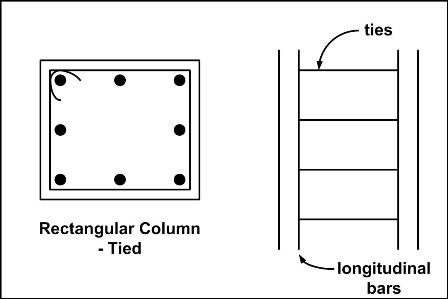
2.2 Number of Longitudinal Bars
According to ACI 318-19, section 10.7.3, the minimum number of bars for concrete columns are as follows:
- Four within rectangular or circular ties.
- Six enclosed by spirals or for columns of special moment frames held by circular hoops.
- Three within triangular ties
Note:
- For columns with large axial forces and small moments, longitudinal bars should be spaced more or less uniformly around the perimeter.
- If bending moments on the column is large, much of the longitudinal steel rebars are concentrated at the highest compression or tension faces, i.e., at maximum distances from the axis of bending.
2.3 Thickness of Concrete Cover
The minimum thickness of concrete cover is 40 cm. However, it may be required to be increased if in special circumstances or when general building code needs greater concrete cover for fire protection:
- For columns that are cast and permanently in contact with the ground, the minimum cover is 7.5 cm.
- For columns exposed to weather or contact with the ground and embedded bars are No. 19 or greater, the minimum concrete cover is 5 cm.
2.4 Spacing Between Longitudinal Bars
The spacing between longitudinal reinforcement of the column should be the greatest of the following:
- 4 cm
- 1.5 times the diameter of the longitudinal bar
- (4/3) times the diameter of maximum aggregate size
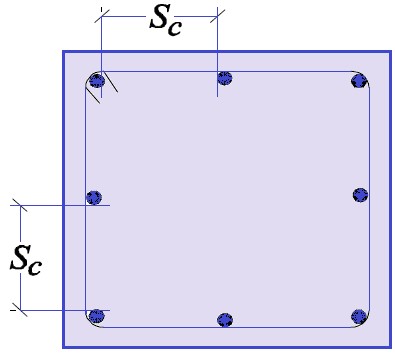
2.5 Bundled Bars
- Bundled bars are groups of parallel bars that are in contact with each other to act as a unit bar. It is used where a heavy concentration of reinforcement is required. Bundled bars save space and reduce congestion for placement and compaction of concrete.
- The maximum number of bundled bars are four.
- Bundled bars shall be enclosed within transverse reinforcement.
- Bundled bars in compression members shall be enclosed by transverse reinforcement at least No. 13 in size.
- Bars larger than a No. 36 shall not be bundled in beams.
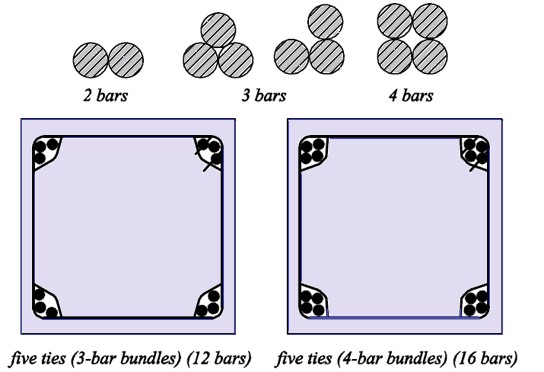
3. Transverse Bars
3.1 Ties
- Ties shall be arranged in a way that every corner and alternate longitudinal bar shall have lateral support provided by the corner of link having an included angle of not more than 135 degrees.
- Transverse ties shall not be farther than 150 mm clear on either side from laterally supported longitudinal bars.
- Ties for columns must have a minimum diameter of 10 mm to enclose longitudinal bars of No. 32 or smaller and a minimum diameter of 12 mm for larger bar diameters.
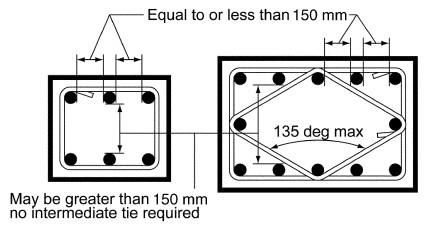

- Spacing of ties shall not exceed the smallest of:
- 48 times the tie diameter
- 16 times the longitudinal bar diameter
- The least dimension of the column
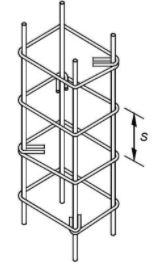
3.2 Circular Individual Ties
Circular ties should be used where longitudinal bars are located around the perimeter of a circle.

3.3 Spirals
- For cast-in-place construction, the spiral bar should not be less than No. 10 bars.
- Minimum clear spacing is the greatest of 25 mm or (4/3) times the diameter of aggregate.
- Maximum clear spacing of 75 mm.
- 1.5 extra turns of spiral bar should anchor spirals at each end.

FAQs
The size of the column is not restricted to allow the use of small concrete column cross-section in lightly loaded concrete structure, as per ACI 318-19. However, IS 456 specifies a minimum column size of 228 mm x 228 mm, contains steel reinforcement of 4 bars of 12 mm supported laterally by stirrups of 8 mm diameter at a distance of 150 mm.
According to ACI 318-19, the spacing of stirrups in the RC column should not exceed the smallest of the following:
1. 48 times the diameter of the tie.
2. 16 times the diameter of the longitudinal bar.
3. The least dimension of the column.
The minimum diameter of stirrup is 10 mm to enclose longitudinal bar of No. 32 or smaller, and minimum diameter of 12 mm for larger longitudinal bars.
According to ACI 318-19, section 10.7.3, the minimum number of bars for concrete columns are as follows:
1. Four within rectangular or circular ties.
2. Six enclosed by spirals or for columns of special moment frames held by circular hoops.
3. Three within triangular ties
The spacing between longitudinal reinforcement of the column should be the greatest of the following:
1. 4 cm
2. 1.5 times the diameter of the longitudinal bar
3. (4/3) times the diameter of maximum aggregate size
Read more
What are the Factors Controlling the Distance Between RCC Columns?
Economical Design of Reinforced Concrete Columns to Reduce Cost


